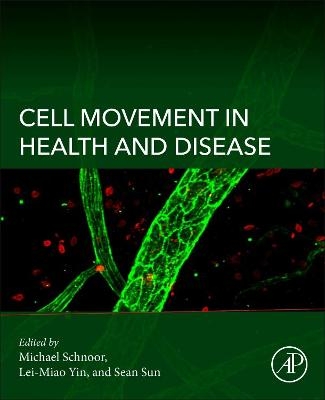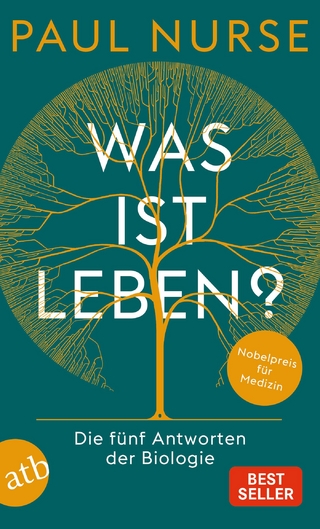
Cell Movement in Health and Disease
Academic Press Inc (Verlag)
978-0-323-90195-6 (ISBN)
The content is presented in four main section. The first explores the foundations of Cell Movement, including overviews of cellular structure, signaling, physiology, motion-related proteins, and the interface with the cellular membrane. The second part covers the biological aspects of cellular movement, starting with chemical and mechanical sensing, describing the types of cell movement, mechanics at cell level, cell physiology, collective behavior, and the connections with the extracellular matrix. The following chapters provide an overview of the molecular machinery involved and cell-type specific movement. The third part of the book is dedicated to the translational aspects of cell movement, highlighting the key conditions associated with cell movement dysfunction, like cell invasion in cancer, wound healing, developmental issues, neurological dysfunctions, and immune response. The final part of the book covers key methods and modeling tools for cell movement research, including predictive mathematical models, in vitro and in vivo methods, biophysical and bioinformatics tools.
Cell Movement in Health and Disease is the ideal reference for scientists from different backgrounds converging to expand the understanding of this key cellular process. Cellular and molecular biologists will gain a better understanding of the physical principals operating at cellular level while biophysicist and biomedical engineers will benefit from the solid biology foundation provided by the book.
Dr. Michael Schnoor received his master’s degree in chemistry from the Institute of Biochemistry, Westphalian Wilhelms University, Münster, Germany and PhD in Biochemistry from the same institution. His post-doc studies with emphasis on immunology and mucosal inflammation was developed at the Emory University, Atlanta, GA, USA. He currently Principal Investigator at the Department for Molecular Biomedicine, Center for Investigation and Advanced Studies, Mexico City, Mexico. His research evolves around inflammation, actin, and actin-binding molecules, endothelial cell contact stability and leukocyte transmigration. Dr. Schnoor has published over 50 articles in peer-review journals and presented in conferences around the world. For his research he received awards from the American Society for Investigative Pathology and is funded by sources both in Germany and Mexico. Dr. Leimiao Yin is currently Professor at the Shanghai University of Traditional Chinese Medicine, Shanghai, China. He is Guest Associate Editor for the Cell Adhesion and Migration special issue from Frontiers in Cell and Developmental Biology. He has published over 40 research articles in international peer-review journals. Sean Sun is a vice-chair and professor in the Department of Mechanical Engineering at the Whiting School of Engineering and at the Physical Science-Oncology Center under INBT. His research improves on current knowledge of cell motility, molecular motors, proteins and membranes, statistical mechanics, and theoretical biomechanics, and biophysics. Dr. Sun was a 2017 inductee as an AIMBE Fellow, for outstanding contributions to our quantitative understanding of cell mechanics, cell motility and force generation mechanisms in live cells. He received his BS from Penn State in 1994 and PhD in theoretical chemistry from the University of California, Berkley, in 1998.
Section 1: Cell biological aspects of cell movement
1. Cell structure and physiology
WANYU ZHAO, WEIDA REN, DICHUN HUANG, YUAN SANG, LINGBO CAO, AND JUNQI HUANG
2. Migrasome in cell movement: new horizon for cell signaling
DICHUN HUANG, RUFEI LIN, SHUCHEN LIU, HENGYI ZHONG, ZHANGSHUAI DAI, AND JUNQI HUANG
3. Cellular substructures, actin dynamics, and actin-binding proteins regulating cell migration
NATHANIEL L. LARTEY AND MICHAEL SCHNOOR
4. Impact of cell-cell interactions on communication and collectiveness
JAZMIN ESPINOSA-RIVERO, CECILIA BANUELOS, AND ABIGAIL BETANZOS
5. Cell migration
YUAN-NA LIN AND ANTON WELLSTEIN
Section 2: Mechano-biological aspects of cell movement
6. Fundamental mechanics of cell shape and cell movement
YIZENG LI AND SEAN X. SUN
7. Extracellular matrixedependent mechanosensing and mechanotransduction: role in cell migration
NATASHA BUWA AND NAGARAJ BALASUBRAMANIAN
8. Cellematrix interactions, force transmission, and mechanosensation
CHRISTOPHER WALTER, HANNAH ZMUDA, JOSE A. ALMEIDA, AND AMIT PATHAK
Section 3: Translational aspects of cell movement
9. Cell movement during development
WEN-CHAO TANG
10. Cell migration in cardiovascular diseases
JENEFA BEGUM, SAMUEL R.C. WEAVER, ASIF J. IQBAL, G. ED RAINGER, AND HELEN M. MCGETTRICK
11. Leukocyte movement during immune responses
EDUARDO VADILLO
12. Migrasomes: the “brightest stars in cardiovascular system?
ZHANG YAXING, LIU WEI, LIU HAIMEI, ZHOU LEQUAN, YAN FUMAN, GUAN LI, AND XU JINWEN
13. Leukocyte trafficking to the intestinal barrier in health and disease
GUSTAVO MONASTERIO, FRANCISCA A. CASTILLO, AND EDUARDO J. VILLABLANCA
14. Cell movement and respiratory diseases
ZHI-YING LV, QI MENG, AND LEI-MIAO YIN
15. Cancer cell development, migratory response, and the role of the tumor microenvironment in invasion and metastasis
INES M. ANTON, FRANCISCO WANDOSELL, AND MIGUEL VICENTE-MANZANARES
Section 4: Methods and modeling tools for cell movement research
16. Microfluidic tools to study cell migration
ROBERTO RODRIGUEZ-MONCAYO, ALAN M. GONZALEZ-SUAREZ, ORESTES LO´ PEZ-ORTEGA, AND JOSE L. GARCIA-CORDERO
17. Using real-time cell analysis to measure cell contraction
DONG-DONG ZHOU, JIN LU, AND LEI-MIAO YIN
18. Advanced microscopy techniques for the visualization and analysis of cell behaviors
DANIEL MERENICH, KATHLEEN E. VAN MANEN-BRUSH, CHRISTOPHER JANETOPOULOS, AND KENNETH A. MYERS
19. Intravital microscopy
IDAIRA M. GUERRERO FONSECA, MICHAEL SCHNOOR, AND EDUARDO VADILLO
20. Mathematical and bioinformatic tools for cell tracking
PETER HIRSCH, LEO EPSTEIN, AND LEO GUIGNARD
| Erscheinungsdatum | 11.04.2022 |
|---|---|
| Zusatzinfo | 130 illustrations (50 in full color); Illustrations |
| Verlagsort | Oxford |
| Sprache | englisch |
| Maße | 216 x 276 mm |
| Gewicht | 1060 g |
| Themenwelt | Naturwissenschaften ► Biologie ► Zellbiologie |
| ISBN-10 | 0-323-90195-6 / 0323901956 |
| ISBN-13 | 978-0-323-90195-6 / 9780323901956 |
| Zustand | Neuware |
| Informationen gemäß Produktsicherheitsverordnung (GPSR) | |
| Haben Sie eine Frage zum Produkt? |
aus dem Bereich
